
Koreatown, or K-Town, is an ethnic Korean enclave in Midtown Manhattan, New York City, centered on 32nd Street between Madison Avenue and the intersection with Sixth Avenue and Broadway, which is known as Greeley Square. The neighborhood in Midtown South features over 150 businesses of various types and sizes, ranging from small restaurants and beauty salons to large branches of Korean banking conglomerates. Koreatown, Manhattan, has become described as the "Korean Times Square" and has emerged as the international economic outpost for the Korean chaebol.
The Twilight Club was a dinner club in New York City that operated from 1883 until 1904. It was founded by Charles F. Wingate "to cultivate good fellowship and enjoy rational recreation."

Midtown Manhattan is the central portion of the New York City borough of Manhattan, serving as the city's primary central business district. Midtown is home to some of the city's most prominent buildings, including the Empire State Building, the Chrysler Building, the Hudson Yards Redevelopment Project, the headquarters of the United Nations, Grand Central Terminal, and Rockefeller Center, as well as several prominent tourist destinations, including Broadway, Times Square, and Koreatown. Penn Station in Midtown Manhattan is the busiest transportation hub in the Western Hemisphere.

The New York Athletic Club is a private social club and athletic club in New York state. Founded in 1868, the club has approximately 8,600 members and two facilities: the City House, located at 180 Central Park South in Manhattan, and Travers Island, located in Westchester County. Membership in the club is by invitation only.

Henry Janeway Hardenbergh was an American architect, best known for his hotels and apartment buildings, and as a "master of a new building form — the skyscraper." He worked three times with Edward Clark, the wealthy owner of the Singer Sewing Machine Company and real estate developer: The Singer company's first tower in New York City, the Dakota Apartments, and its precursor, the Van Corlear. He is best known for building apartment dwellings and luxury hotels.

Sixth Avenue, also known as Avenue of the Americas, is a major thoroughfare in the New York City borough of Manhattan. The avenue is commercial for much of its length, and traffic runs northbound, or uptown.

The Racquet and Tennis Club, familiarly known as the R&T, is a private social and athletic club at 370 Park Avenue, between East 52nd and 53rd Streets in Midtown Manhattan, New York City.

The New York Yacht Club (NYYC) is a private social club and yacht club based in New York City and Newport, Rhode Island. It was founded in 1844 by nine prominent sportsmen. The members have contributed to the sport of yachting and yacht design. As of 2001, the organization was reported to have about 3,000 members. Membership in the club is by invitation only. Its officers include a commodore, vice-commodore, rear-commodore, secretary and treasurer.

Axa Equitable Center is an office skyscraper at 787 Seventh Avenue, between 51st and 52nd Streets, in the Midtown Manhattan neighborhood of New York City. Completed in 1986 and designed by Edward Larrabee Barnes, the building measures 752 feet (229 m) tall with 54 stories. Equitable Center West was developed by the Equitable Life Assurance Society adjacent to Equitable's existing skyscraper at 1285 Avenue of the Americas.

The University Club of New York is a private social club at 1 West 54th Street and Fifth Avenue in the Midtown Manhattan neighborhood of New York City. Founded to celebrate the union of social duty and intellectual life, the club was chartered in 1865 for the "promotion of literature and art". The club is not affiliated with any other University Club or college alumni clubs. The club is considered one of the most prestigious in New York City.

The Yale Club of New York City, commonly called The Yale Club, is a private club in Midtown Manhattan, New York City. Its membership is restricted almost entirely to alumni and faculty of Yale University. The Yale Club has a worldwide membership of over 11,000. The 22-story clubhouse at 50 Vanderbilt Avenue, opened in 1915, was the world's largest clubhouse upon its completion and is still the largest college clubhouse ever built.

The Princeton Club of New York was a private clubhouse located at 15 West 43rd Street in Midtown Manhattan, New York City, New York, founded in 1866 as the Princeton Alumni Association of New York. It reorganized to its current name in 1886. Its membership was composed of alumni and faculty of Princeton University, as well as 15 other affiliated schools.

Andrew Freedman was an American businessman who is primarily remembered as the owner of the New York Giants professional baseball team of the National League from 1895 to 1902. He also briefly owned the Baltimore Orioles of the American League in 1902; the franchise would later relocate, and became the New York Yankees. Freedman was also a director of various companies, including the Interborough Rapid Transit Company and the Wright Company. He was born and died in New York City.

The USA Track & Field Outdoor Championships is an annual track and field competition organized by USA Track & Field, which serves as the American national championships for the sport. Since the year 1992, in the years which feature a Summer Olympics, World Athletics Championships, Pan American Games, NACAC Championships, or an IAAF Continental Cup, the championships serve as a way of selecting the best athletes for those competitions.

Charles Hitchcock Sherrill was an American politician, diplomat, sport officer, and author.

The Cornell Club of New York, usually referred to as The Cornell Club, is a private club in Midtown Manhattan, New York City. Its membership is restricted to alumni and faculty of Cornell University, family of Cornellians, business associates of Members, and graduates of The Club's affiliate schools.
The American Football Union (AFU) was a coalition of amateur, semi-professional, and collegiate club football teams that operated from 1886 to 1895 in the New York metropolitan area. Although the minor league was practically inconsequential and obscure in the development of professional American football, the Orange Athletic Club, who participated in the league from 1888 to 1895, would go on to become the Orange and Newark Tornadoes, and join the NFL for two seasons in 1929 and 1930.

National Association of Amateur Athletes of America (NAAA) was formed in 1879. This was the organized body for the Amateur Athletes before the Amateur Athletic Union (AAU) took over in 1888.

The Engineers' Club Building, also known as Bryant Park Place, is a residential building at 32 West 40th Street in the Midtown Manhattan neighborhood of New York City, United States. Located on the southern edge of Bryant Park, it was constructed in 1907 along with the adjoining Engineering Societies' Building. It served as the clubhouse of the Engineers' Club, a social organization formed in 1888. The building was designed by Henry D. Whitfield and Beverly S. King, of the firm Whitfield & King, in the neo-Renaissance style.

The New York Yacht Club Building is a seven-story Beaux-Arts clubhouse at 37 West 44th Street in the Midtown Manhattan neighborhood of New York City, United States. Opened in 1901, the building was designed by architect Whitney Warren of Warren and Wetmore as the sixth clubhouse of the New York Yacht Club (NYYC). The clubhouse is part of Clubhouse Row, a concentration of clubhouses on 44th Street between Fifth and Sixth avenues. The building is a New York City designated landmark and is listed on the National Register of Historic Places as a National Historic Landmark.

















